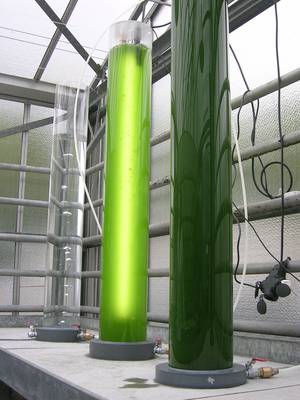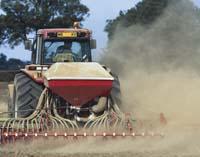Microalgae, gas station supplier
2010/10/01 Lakar Iraizoz, Oihane - Elhuyar Zientzia Iturria: Elhuyar aldizkaria
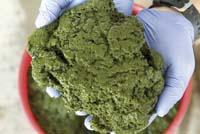
The Inasmet-Tecnalia Energy Unit addressed the study of microalgae to analyze whether everything that began to hear about the potential as the raw material of biofuels was "insignificant". This is what Amaya Arteche, a microalgae researcher, says. Three years have passed since then and are currently immersed in several projects. Neiker-Tecnalia has also investigated microalgae as a source of energy in the last year and a half.
In addition to technology centers, numerous large companies involved in bioenergy issues, such as Repsol, Aurantia, Abengoa and Acciona, have announced that they are conducting microalgae research for the generation of biofuels.
Two recently published news show the interest of companies. On the one hand, the oil company Repsol has announced the acquisition of 20% of the company AlgaEnergy. The company created in 2007 maintains various patents and collaboration agreements with the CSIC and several Spanish universities on microalgae. On the other hand, Iberdrola leads the project called VIDA. The project has among its objectives the development of new technologies for access to energy from microalgae and will continue until 2013. In addition to Iberdrola, 15 other companies and 25 technology centers participate, including Neiker-Tecnalia.
Microalgae sources are considered second-generation biofuels. The differences with respect to biofuels that have increased the most so far, from the seeds of the plants are very diverse. Food raw materials are not destined to the generation of energy, agricultural land is not used, it is not necessary to use irrigation water, since algae that grow in wastewater or salted, could be used as source of CO 2 the fumes emitted by various industries, etc. In addition, microalgae fertility is much higher per unit of surface than most of the terrestrial plants that grow to produce biofuels. For example, one hectare of rapeseed provides 1,500 liters of oil and one hectare of 6,000 palm trees. Thus, microalgae can contribute between 20,000 and 80,000 liters of oil per hectare.
In view of these advantages, for four or five years "the demand of the energy entities has grown very quickly and in a very short time they have started to work a lot of groups, with a lot of species, with many systems of growth, in many climatic regions, etc. ", explains Sonia Castañón, head of the Biotechnology Department of Neiker-Tecnalia.
An example of the speed of research and the pretension to show that the results are good has been the demonstration that took place in June in Berlin: for the first time a plane used fuel from algae as fuel. However, the researchers have it clear: ignorance is still very big.
Raw materials various fuels
In general, three types of fuels can be produced from microalgae: combustion biomass, bioethanol and biodiesel. These monocellular organisms are used as small factories that produce raw materials to convert them into biofuels. As plants are photosynthesizers, they absorb CO 2 with light energy and convert carbon into biomass, sugars or lipids.
In the case of biomass, the fuel is the same algae cultivated: the energy is obtained by burning the algae cultivated. Sugars and lipids must be modified. The production of bioethanol from sugar is carried out through a fermentation process and, of lipids, through industrial processes called biodiesel, sterification and transesterification.
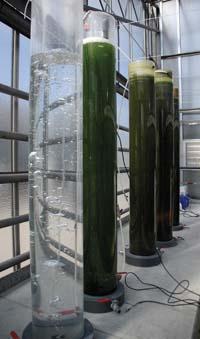
All these industrial processes of fuel generation are already known. In short, microalgae follow the same methodologies that were previously used with plants.
Need for improvement in growth processes
As for the conditions of growth and raw materials that can be extracted from them, "microalgae are perfect for producing biofuels," says Arteche. "Theoretically perfect. But there is a lot to improve in these processes," he added.
"It would be a foolishness, for example, to waste more energy than will be provided by algae as a source of energy in the growth and processing of algae, or to spend more than the money you will get in the fuel generation process," said Arteche.
In other markets where microalgae products are extracted, such as pharmacy or cosmetics, the situation is very different. These are markets of high added value so the algae crops that work for them can face high production and processing costs. "In the case of biodiesel, the benefits are much lower. Therefore, it is necessary to cut costs a lot", explains Arteche.
In the case of biodiesel, for example, you have to choose species of lipid rich microalgae and know what type of water and what conditions you need to grow. In addition, it is necessary to know very well the life cycle and the metabolism of algae to know when is the most suitable time for harvesting. As living beings, they are the phases of the cycle in which they have the most lipids.
As for the harvest, there is much to improve in terms of the separation of algae from water. "In the liquid collected in the nursery, the algae only fill between 2 and 5%," said Arteche. The rest is water. The most efficient way to carry out this work is the use of centrifuges, which consume a lot of energy. However, in recent times, the efficiency of centrifuges is increasing and significant reductions in consumption are taking place.
Once the biomass is separated from the water, the algae themselves must be processed. Biodiesel production requires the extraction of lipids. By mechanical methods, microalgae are fed by chemical methods, such as solvents, or a combination of both methods.
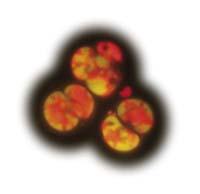
Once extracted, take into account the type of oil obtained. Like the oils that provide sunflower seeds and rapeseed seeds, they are different ones that provide the different species of algae. Therefore, it is necessary to characterize them and see if it is necessary to add additives to obtain biofuels approved later.
From there, converting the oil into biodiesel is better known, more universal. "It has difficulties, but it's something more standardized," says Arteche. For this reason, the Basque research centers are working to improve and optimize the steps to harvest.
What to Investigate
The first work to be done by research centers is to choose which aspects of improvement to address. In Inasmet-Tecnalia, for example, a first study was carried out to know the situation of the market and of the technologies. It was also analyzed which phase of algae production had the greatest need for improvement.
They now collaborate with biofuel producing companies. Once chosen the most suitable species for each project, it took "several months" to know the algae, as Arteche explained, to know what metabolism it has, how it grows, how it reproduces, when it should be harvested, etc. To do this, they have designed a 40-50 liter photobioreactor or nursery for each of them, with the aim of continuously collecting data on growth, such as temperature, pH of water, oxygen concentrations and CO 2, etc.
In the investigations that are being carried out, processes of separation between algae and water are being studied, among others: "Centrifugation, micro-ultrafiltration, usual treatments in purification plants (floculation and flotation)... We are testing different methods of differentiation and seeing what quality they give each other", he said. In addition, algae oil extraction systems are being prepared and optimized. "This extracted oil would be ready to be subjected to a biofuel process," explains Arteche.
From the Neiker-Tecnalia Department of Biotechnology, research has been focused on other ways. Instead of trying to improve the growth and distribution processes, we are working on the selection of species and algae strains that "can give the best results for a given use".
They also have a collection of species of about 30 species. "We started the collection with the species we needed to start researching, and now we're adding what we need in the projects that arise, or what we pick up here and there in our activity," says Castañón.
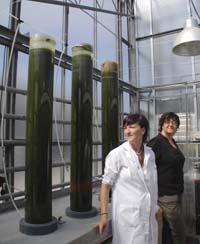
On the other hand, to make the production of microalgae destined for the production of biofuels, they seek something that contributes added value to the algae. That is to say, once extracted the components of interest for the production of biofuels, "they look for molecules that can be of interest for other purposes", explains Castañón, in the remaining biomass: essential fatty acids, pigments, antioxidant molecules, immunostimulants, etc.
Genetic transformation, an alternative
Another way to make the production of microalgae profitable is to generate more lipids. This is the goal of another line of research underway by Neiker-Tecnalia, based on genetic engineering. That is, they are investigating the gene transformations that affect the enzymes of the metabolic path that synthesizes lipids. The basis is to introduce some other gene into the genes that produce these enzymes to express themselves in an exaggerated way.
For this purpose, the bacterium Agrobacterium tumefaciens is being used. The bacteria spontaneously introduce them to the plants that infect some of their genomic fragments. In fact, in these small chunks it has genes to accelerate the growth of plants and produce nutrients for the bacteria. Well, introducing instead genes that regulate the synthesis of lipids, the researchers intend to get the microalgae to produce more lipids.
Seeing that there are so much research, research, aspects of improvement and fields of study, it does not seem difficult, according to Arteche, that in the field of biofuels "they become promising raw materials. We believe they will compete with fossil fuels. But not yet. Today, it seems that the only way to make this whole process profitable is to extract different molecules from microalgae. The costs are high, there are many areas of improvement and we have to adapt, adapt and optimize the entire network".
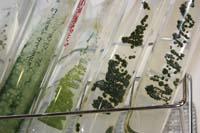

Gai honi buruzko eduki gehiago
Elhuyarrek garatutako teknologia




